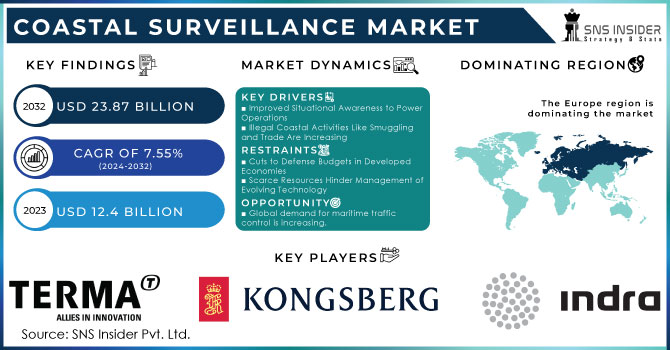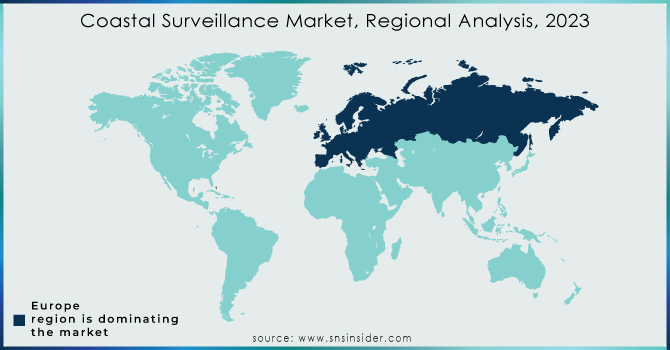Coastal Surveillance Market Report Scope & Overview:
The Coastal Surveillance Market Size was valued at USD 12.4 billion in 2023 expected to reach USD 23.87 billion by 2032 with a growing CAGR of 7.55% over the forecast period 2024-2032. Coastal surveillance protects the country's boundaries from terrorism or other intrusions in coastal areas. It also aids in the detection of smuggling, illegal fishing, and other immoral acts. CSS ensures the safety of marine traffic inside national waters, coasts, and ports. This technology also scans and monitors the water within the coastal boundaries for un-authorised activities. It is responsible for the continual and uninterrupted surveillance and inspection of all ships and boats. These important aspects are promoting the expansion of the coastal surveillance market. However, a lack of resources to manage changes in the technical environment may limit its expansion in emerging economies.

To get more information on Coastal Surveillance Market - Request Free Sample Report
MARKET DYNAMICS
KEY DRIVERS
-
Improved Situational Awareness to Power Operations
-
An increase in the number of illegal coastal activities, including as smuggling and illegal trades, has occurred.
RESTRAINTS
-
Resources are scarce to manage the changing technological environment.
-
Cuts to Defense Budgets in Developed Economies
OPPORTUNITIES
-
Increased Demand from Coastal Surveillance Centers for Submarine Periscope and Radar Antenna Detection.
-
Global demand for maritime traffic control is increasing.
CHALLENGES
-
Improved Target Tracking and Guidance Paradigms in Surveillance Radar Systems
-
The Rise of Stealth Technology
THE IMPACT OF COVID-19
The demand side of the coastal surveillance radar market remained unchanged in 2020, despite a minor delay in lead time. Furthermore, despite the fact that the number of illnesses in APAC is expected to rise in 2021, governments have relaxed containment rules and permitted industrial plants to operate. For example, despite the massive second wave in India in the second quarter of 2021, the Indian Government and Bharat Electronics Limited continued the development and deployment of coastal surveillance radars through a Transfer of Technology Agreement initiated in November 2020 with Terma A/S. Similarly, despite an increase in the frequency of illnesses in China, the development and deployment of coastal monitoring radar in 2021 remained unaltered. As a result, COVID-19 will have a minor impact on the coastal surveillance radar market in 2020.
The coastal surveillance market can be divided into command and control, communications, computers, intelligence, surveillance and reconnaissance, and electronic warfare. Because of the use of radio networks to transmit intelligence and surveillance information from global positioning systems to video and sensor data, the intelligence category is predicted to develop at the fastest CAGR.
The coastal surveillance market can be divided into three segments based on end-user: naval, coast guard, and other users. The naval segment dominates the coastal surveillance market and is likely to maintain its dominance in the coming years due to benefits such as broad monitoring regions, low interruptions, and easy coordination.
KEY MARKET SEGMENTATION
By Application
-
Command & Control
-
C2
-
Communication
-
Computers
-
Intelligence
-
Surveillance & Reconnaissance
-
Electronic Warfare
By End Useation
-
Regional
-
Port
REGIONAL ANALYSIS:
North America, Europe, Asia Pacific, and the rest of the world make up the Coastal Surveillance market. Because of the region's high defence spending and rising use of modern surveillance technologies. Because of the existence of important players such as Thales Group and Kongsberg Gruppen, the European market is expected to increase moderately. Due to rising demand for coastal surveillance systems and increased military spending in countries such as India and China, the Asia-Pacific market is likely to be the fastest-growing area in the worldwide coastal surveillance market. Furthermore, markets in Latin America and the Middle East and Africa are expected to grow at a rapid pace during the forecast period.

Need any customization research on Coastal Surveillance Market - Enquiry Now
REGIONAL COVERAGE:
-
North America
-
USA
-
Canada
-
Mexico
-
-
Europe
-
Germany
-
UK
-
France
-
Italy
-
Spain
-
The Netherlands
-
Rest of Europe
-
-
Asia-Pacific
-
Japan
-
south Korea
-
China
-
India
-
Australia
-
Rest of Asia-Pacific
-
-
The Middle East & Africa
-
Israel
-
UAE
-
South Africa
-
Rest of Middle East & Africa
-
-
Latin America
-
Brazil
-
Argentina
-
Rest of Latin America
-
KEY PLAYERS
The Major Players are Terma A/S, Kongsberg Gruppen ASA, SAAB AB, Elbit Systems Ltd., Indra Sistemas S A, The Raytheon Company, Lockheed Martin Corporation, Northrop Grumman Corporation, Thales Group, Selex Es Spa, and other players.
| Report Attributes | Details |
|---|---|
| Market Size in 2023 | US$ 12.4 Billion |
| Market Size by 2032 | US$ 23.87 Billion |
| CAGR | CAGR of 7.55% From 2024 to 2032 |
| Base Year | 2023 |
| Forecast Period | 2024-2032 |
| Historical Data | 2020-2022 |
| Report Scope & Coverage | Market Size, Segments Analysis, Competitive Landscape, Regional Analysis, DROC & SWOT Analysis, Forecast Outlook |
| Key Segments | • By Application (Command & Control, C2, Communication, Computers, Intelligence, Surveillance & Reconnaissance, and Electronic Warfare) • By End Use (Naval, Coast Guard) • By Structure (National, Regional, and Port) |
| Regional Analysis/Coverage | North America (USA, Canada, Mexico), Europe (Germany, UK, France, Italy, Spain, Netherlands, Rest of Europe), Asia-Pacific (Japan, South Korea, China, India, Australia, Rest of Asia-Pacific), The Middle East & Africa (Israel, UAE, South Africa, Rest of Middle East & Africa), Latin America (Brazil, Argentina, Rest of Latin America) |
| Company Profiles | Terma A/S, Kongsberg Gruppen ASA, SAAB AB, Elbit Systems Ltd., Indra Sistemas S A, The Raytheon Company, and Lockheed Martin Corporation, Northrop Grumman Corporation, Thales Group, Selex Es Spa, and other players. |
| DRIVERS | • Improved Situational Awareness to Power Operations • An increase in the number of illegal coastal activities, including as smuggling and illegal trades, has occurred. |
| RESTRAINTS | • Resources are scarce to manage the changing technological environment. • Cuts to Defense Budgets in Developed Economies |

